Day 4 of a five day Spring Migration tour today. It dawned bright and sunny and the wind had dropped too. A great day to be out birding! We made our way up to NW Norfolk for the day.
We started the day at Snettisham Coastal Park. As we walked out through the bushes, lots of warblers were starting to sing – Common Whitethroat, Blackcap, Chiffchaff, Willow Warbler and lots of Sedge Warblers. They have all returned in some numbers now and this is always a great site to see them. The first Lesser Whitethroat we came across wasn’t singing, but we heard it call – a more delicate ‘tak’ than a Blackcap – and then found it hopping around in the top of a low hawthorn. Cetti’s Warbler is a resident, rather than a migrant, but they are all in full voice now too, shouting at us from various bushes and brambles.
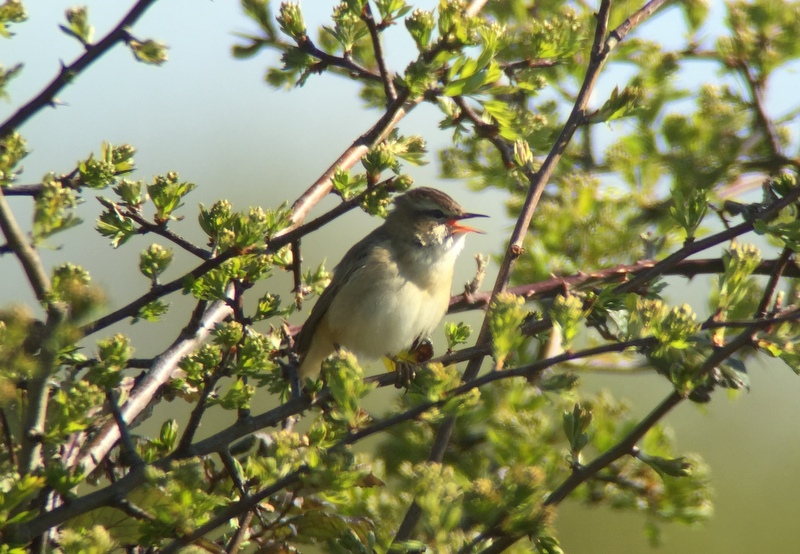 Sedge Warbler – there were lots singing at Snettisham today
Sedge Warbler – there were lots singing at Snettisham today
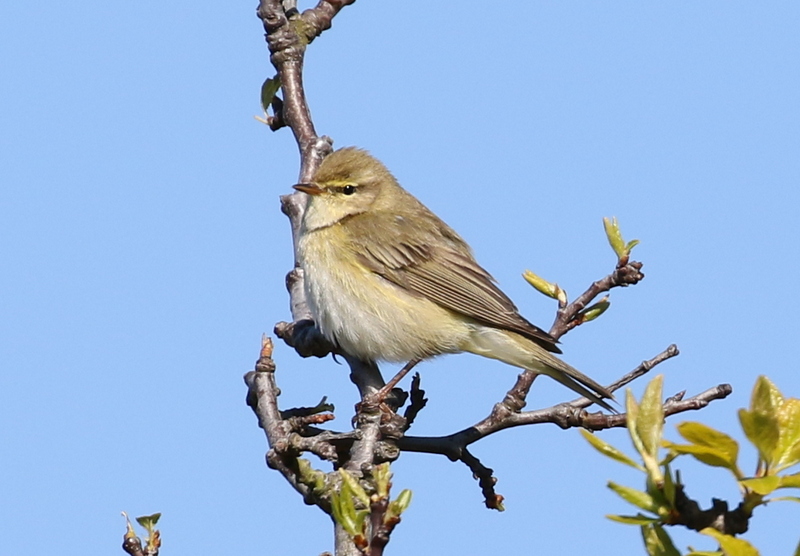 Willow Warbler – singing from the trees
Willow Warbler – singing from the trees
 Chiffchaff – there were lots in the bushes
Chiffchaff – there were lots in the bushes
There were spring migrants on the move. The first Swallows of the morning came overhead – there was a steady passage of birds along the coast today. A couple of Common Swifts went through too.There were also a few more Yellow Wagtails today – we heard at least six pass over while we were at Snettisham, and managed to see one which came through a bit lower above us.
A Cuckoo flew across and disappeared into the bushes before everyone could get onto it. A smart pair of adult Mediterranean Gulls flew over towards the Wash, flashing their pure white wingtips as they went.
As we rounded the next corner, a Ring Ouzel flew out of the trees into a big clearing and landed with a couple of Blackbirds behind some low bushes. We moved slowly round to where we could see it feeding on the grass. It was a female Ring Ouzel – browner bodied than a male and with a distinct off dirty, off-white colour to the crescent on the breast. Still it was great to watch it hopping around on the ground out in the open, until something spooked it and it flew back into cover.
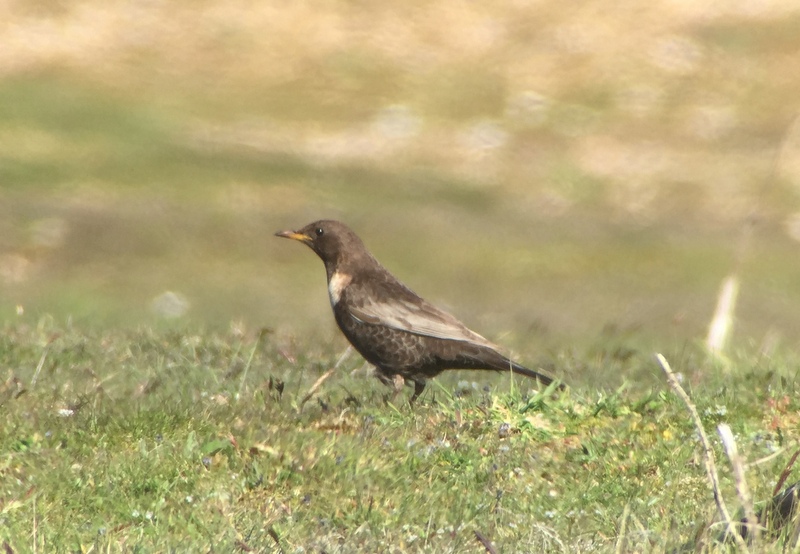 Ring Ouzel – this female showed well today
Ring Ouzel – this female showed well today
We hadn’t gone much further when we saw a flash of red in front of us as a cracking male Redstart landed in a bush. Unfortunately it flew again before we had time to get it in the scope – some dogwalkers were coming along the path in the opposite direction and had flushed it. Thankfully, after they had gone, it flew straight back out to what were obviously its favoured bushes and this time we got a great look at it. Its bright white forehead and red breast and belly really shone in the morning sunshine.
 Redstart – this stunning male brightened up our morning
Redstart – this stunning male brightened up our morning
The Redstart eventually disappeared off across the path and we continued on past it. Quite a bit further on, another flash of red and a second Redstart appeared, another male, but not as bright as the first. A short distance further and we flushed a third male Redstart and then we came across a female too. We watched the female for some time, flicking between bushes and feeding underneath them. Quite a haul – four spring Redstarts in one morning.
The Coastal Park is normally a good site for Grasshopper Warbler, but we only heard one at first as we walked up through the bushes, and that reeled only very briefly. Then it all changed – we heard one reeling quite close by and made our way over to try to see it. It was not particularly amenable, but perched half obscured in the top of a low hawthorn. While we were trying to see it, another Grasshopper Warbler started reeling on the other side of some trees from where we were standing. When we gave up and continued on a little further, we heard yet another Grasshopper Warbler and this one gave itself up nicely, perching out in the sunshine while it delivered its peculiar mechanical clicking song, ‘reeling’.
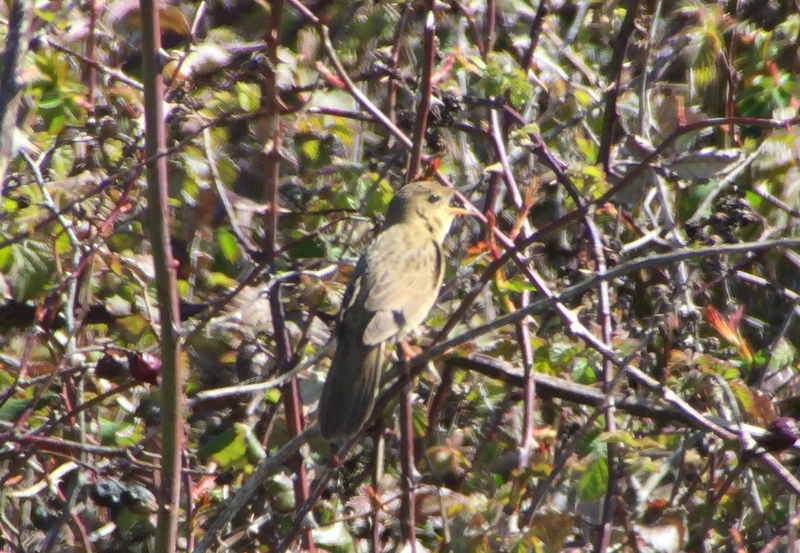 Grasshopper Warbler – the fourth we heard perched up nicely
Grasshopper Warbler – the fourth we heard perched up nicely
The walk back along the inner seawall was less eventful. As we turned to head back south, we did see three Whimbrel out on the grass further along. There were lots of Greylags, Egyptian Geese and Shelduck on the grazing marshes, but no sign of any Pink-footed Geese here today. All the warblers were still singing as before, but we did also hear a couple of Reed Warblers and a Lesser Whitethroat actually singing its rattling song.
We had a brief look out at the Wash while we were at the Coastal Park, but the tide was in here, so we made our way down to the pits to try to see some waders. It was not a big high tide today, so there was still a lot of exposed mud, but we could see a huge flock of Knot and Grey Plover spread out across the mud. Even better, something spooked them just after we had arrived and we got a great display of thousands and thousands of birds wheeling round in the sky.

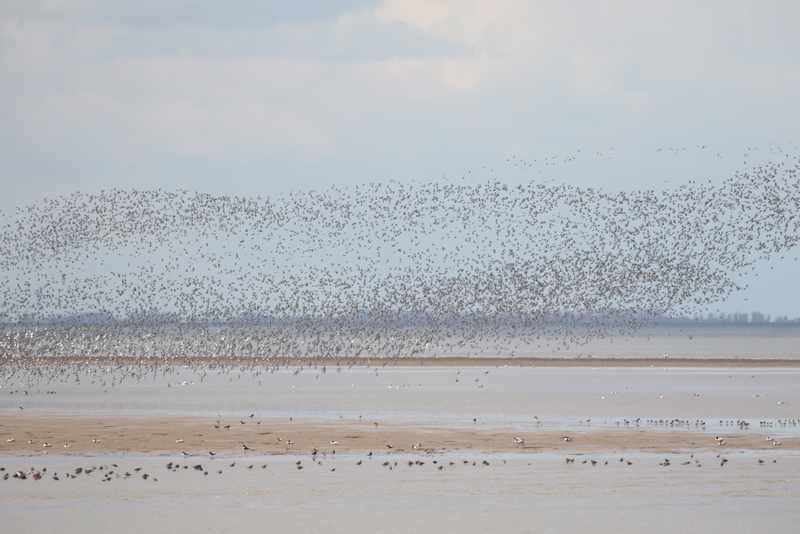
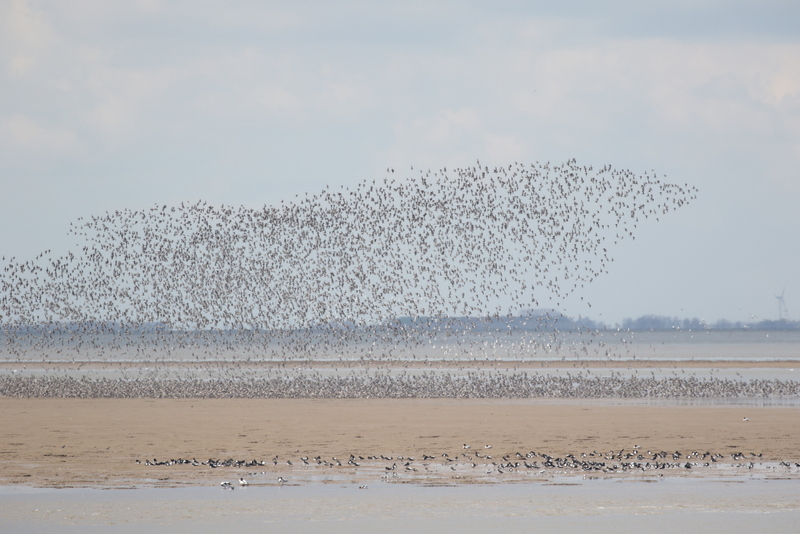 Waders – we were treated to a great display of a whirling flock
Waders – we were treated to a great display of a whirling flock
There was a nice selection of waders closer in. A large flock of Black-tailed Godwits was loafing around and preening in the channel just below the seawall. We managed to pick out a couple of Bar-tailed Godwits on the mud too, and even better at one point we had a Black-tailed and a Bar-tailed Godwit standing together on the edge of the water, a nice side-by-side comparison. There were good numbers of Oystercatcher too, plus a few Avocets and a sprinkling of Dunlin running around in amongst them. A couple of Sandwich Terns were resting on the mud too, and took off to fly round calling.
Our next stop was at Holme and, after lunch, we had a quick walk round the paddocks. We could neither hear nor see the Turtle Dove which had been reported that morning and otherwise the bushes were a little quiet. A group of four Siskins flew over, heading west, more birds on the move. We came back via the road – the gardens provided a Pied Wagtail, lots of House Sparrows, a pair of Mallard resting up on the ridge tiles on a roof and a couple of Swallows preening on the wires.
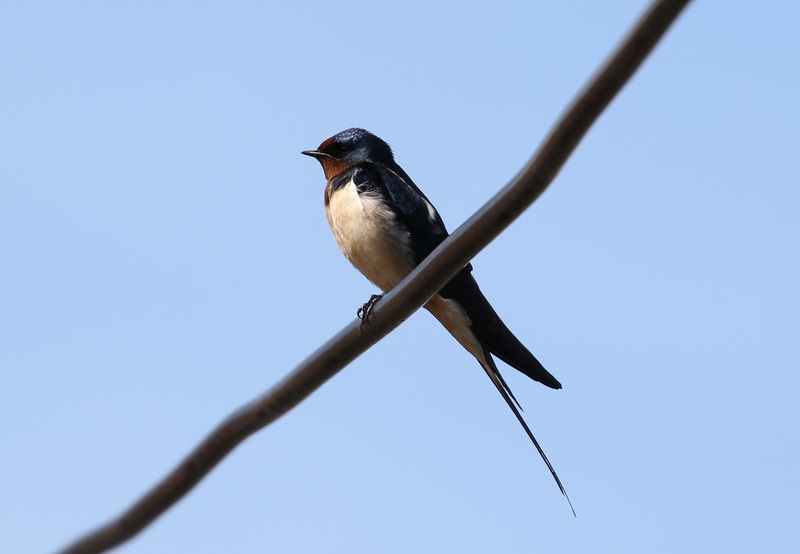 Swallow – preening on the wires at Holme
Swallow – preening on the wires at Holme
There has been a Black Redstart further down by the Firs at Holme for several days now, so we made our way down to try to see that next. There was no sign of it around the paddocks from the car as we drove past, just several Wheatears hopping around down on the grass. But after parking and walking back for a proper look, we quickly found the Black Redstart perched on a fence post. We watched it for a while as it kept dropping down to the ground looking for food, coming back up to the posts, wires, or into a low hawthorn tree. It was a female, so overall a dirty grey colour, but still sporting a nice red tail.
 Black Redstart – a female in the paddocks at Holme
Black Redstart – a female in the paddocks at Holme
Our last stop of the day was at Titchwell.After all our travels, we did not have as much time to explore here as we normally do, so it was a bit of a whistle-stop tour. On the dried up grazing marsh ‘pool’, we quickly found a single White Wagtail, along with several Pied Wagtails. Two more White Wagtails were on the Freshmarsh later.
A female Bearded Tit was flitting around in the reeds here briefly when we arrived, but quickly flew off across the path into the main reedbed. However, up at the reedbed pool we were treated to nice views of a male Bearded Tit swinging around on a reed head. A couple of Marsh Harriers were quartering over the reeds and a Great Crested Grebe was lurking in the far corner of the water.
The water level of the Freshmarsh is still quite high and consequently there was nothing in front of Island Hide, so we headed straight for Parrinder Hide. That was the right thing to do, as we quickly picked up the Little Stint out on one of the islands in front. It was noticeably small, particularly when two Redshanks dropped in next to it, smaller than the nearby Dunlin and with a considerably shorter bill.
 Little Stint – still out on the Freshmarsh today
Little Stint – still out on the Freshmarsh today
There were also a couple of Common Terns on one of the islands. A small flock of Black-tailed Godwits were sleeping. A Little Ringed Plover flew past, but we didn’t see it land. The Avocets by the bank were trying to feed, but were up to their bellies in water.
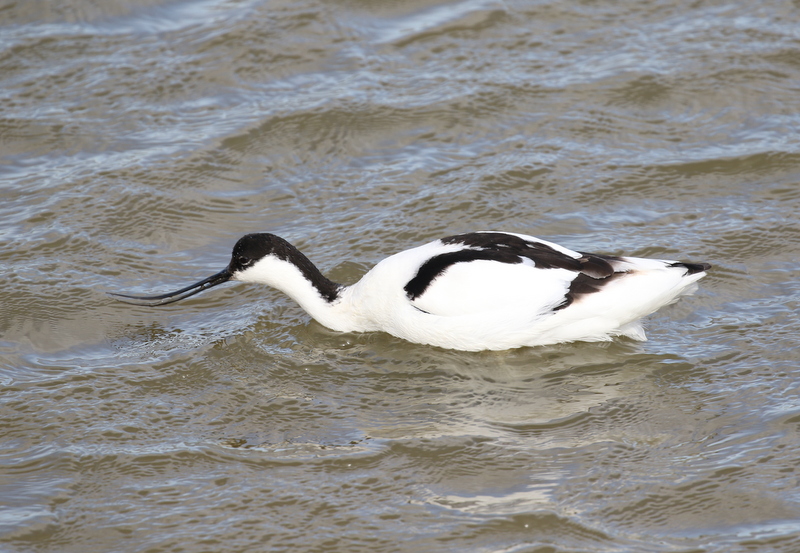 Avocet – trying to feed in the deep water
Avocet – trying to feed in the deep water
There are rather few ducks left on here now, compared to the winter, but still a nice selection. A few Teal were feeding by the bank. In front of Parrinder Hide, we had some nice close Shelduck, Gadwall and Shoveler.
 Shelduck – a pair were in front of Parrinder Hide
Shelduck – a pair were in front of Parrinder Hide
 Gadwall – a pair of these too were in front of Parrinder Hide
Gadwall – a pair of these too were in front of Parrinder Hide
 Shoveler – several pairs were on the Freshmarsh
Shoveler – several pairs were on the Freshmarsh
The Volunteer Marsh and Tidal Pools are rather quiet now, so we made our way straight out to the beach next. The tide was still on its way out and most of the shellfish beds were still underwater. There were lots of Turnstone and Sanderling picking around the seaweed on the shoreline. When something spooked them, all the Turnstone flew to a small outcrop poking above the waves just offshore, and we could see there were some super smart summer plumage birds there, with lots of white around the head and bright rusty feathers in the upperparts. The Sanderling whirled round over the sea before landing back down on the beach.
There was not much happening offshore today, but we did manage to pick up three Little Terns passing west just offshore. Unfortunately then we ran out of time – we had to be back in Wells in good time, so we made our way quickly back to the car. Still, we had enjoyed another great day out.
















